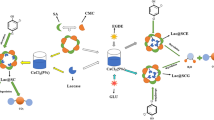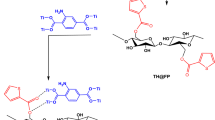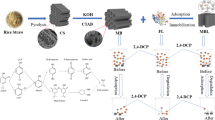Abstract
Immobilization of enzyme based on combination of adsorption and cellulose derivative membrane coating was established in this work for the first time. Laccase, a commonly used enzyme in varied fields, was chosen as the model enzyme to demonstrate this method. After investigating operational conditions, the optimal process was obtained as follows: diatomite or HPD-417 as the adsorption carrier, 0.5% (w/v) methylcellulose (40,000~50,000) acetone solution as the coating solution, 0.75% (w/v) polyethylene glycol or maltose as the protective agent, and drying at 4 °C for 9 h. Under the optimal conditions, the residual activities of diatomite and HPD-417 immobilized laccase reached 99.33% and 94.15%, respectively. The study on properties showed that the immobilized laccases held high pH tolerance and thermal stability. The immobilized laccases were further applied to the indigo decolorization and 2, 4-dichlorophenol degradation. They showed high catalytic efficiency and could be reused for several batches. On the whole, the immobilization method developed in this work can effectively avoid the inactivation of laccase during immobilization and improve the stability of immobilized laccase. The laccase immobilized by this method shows obvious potential for environmental governance.







Similar content being viewed by others
References
Zheng, G. W., & Xu, J. H. (2011). New opportunities for biocatalysis: driving the synthesis of chiral chemicals. Current Opinion in Biotechnology, 22(6), 784–792.
Shi, J., Wu, Y., Zhang, S., Tian, Y., Yang, D., & Jiang, Z. (2018). Bioinspired construction of multi-enzyme catalytic systems. Chemical Society Reviews, 47(12), 4295–4313.
Truppo, M. D. (2017). Biocatalysis in the pharmaceutical industry: the need for speed. ACS Medicinal Chemistry Letters, 8(5), 476–480.
Eijsink, V. G., Gåseidnes, S., Borchert, T. V., & van den Burg, B. (2005). Directed evolution of enzyme stability. Biomolecular Engineering, 22(1–3), 21–30.
Zhang, Y., Ge, J., & Liu, Z. (2015). Enhanced activity of immobilized or chemically modified enzymes. ACS Catalysis, 5(8), 4503–4513.
Das, A., Paul, T., Ghosh, P., Halder, S. K., Mohapatra, P. K. D., Pati, B. R., & Mondal, K. C. (2015). Kinetic study of a glucose tolerant β-glucosidase from Aspergillus fumigatus ABK9 entrapped into alginate beads. Waste and Biomass Valorization, 6(1), 53–61.
Datta, S., Christena, L. R., & Rajaram, Y. R. S. (2013). Enzyme immobilization: an overview on techniques and support materials. 3. Biotech, 3(1), 1–9.
Rodrigues, R. C., Ortiz, C., Berenguer-Murcia, Á., Torres, R., & Fernández-Lafuente, R. (2013). Modifying enzyme activity and selectivity by immobilization. Chemical Society Reviews, 42(15), 6290–6307.
Altinkaynak, C., Tavlasoglu, S., & Ocsoy, I. (2016). A new generation approach in enzyme immobilization: organic-inorganic hybrid nanoflowers with enhanced catalytic activity and stability. Enzyme and Microbial Technology, 93, 105–112.
Ranjbakhsh, E., Bordbar, A., Abbasi, M., Khosropour, A., & Shams, E. (2012). Enhancement of stability and catalytic activity of immobilized lipase on silica-coated modified magnetite nanoparticles. Chemical Engineering Journal, 179, 272–276.
Hoarau, M., Badieyan, S., & Marsh, E. N. G. (2017). Immobilized enzymes: understanding enzyme–surface interactions at the molecular level. Organic & Biomolecular Chemistry, 15(45), 9539–9551.
Al-Qodah, Z., Al-Shannag, M., Al-Busoul, M., Penchev, I., & Orfali, W. (2017). Immobilized enzymes bioreactors utilizing a magnetic field: a review. Biochemical Engineering Journal, 121, 94–106.
Garcia-Galan, C., Berenguer-Murcia, Á., Fernandez-Lafuente, R., & Rodrigues, R. C. (2011). Potential of different enzyme immobilization strategies to improve enzyme performance. Advanced Synthesis & Catalysis, 353(16), 2885–2904.
Fernández-Fernández, M., Sanromán, M. Á., & Moldes, D. (2013). Recent developments and applications of immobilized laccase. Biotechnology Advances, 31(8), 1808–1825.
Sheldon, R. (2013). A; van pelt, S. Enzyme immobilisation in biocatalysis: why, what and how. Chemical Society Reviews, 42(15), 6223–6235.
Jesionowski, T., Zdarta, J., & Krajewska, B. (2014). Enzyme immobilization by adsorption: A review. Adsorption, 20(5–6), 801–821.
Cao, J., Xu, J. J., Liu, X. G., Wang, S. L., & Peng, L. Q. (2016). Screening of thrombin inhibitors from phenolic acids using enzyme-immobilized magnetic beads through direct covalent binding by ultrahigh-performance liquid chromatography coupled with quadrupole time-of-flight tandem mass spectrometry. Journal of Chromatography A, 1468, 86–94.
Bolibok, P., Wiśniewski, M., Roszek, K., & Terzyk, A. P. (2017). Controlling enzymatic activity by immobilization on graphene oxide. Natural Science, 104(3–4), 36.
Khaldi, K., Sam, S., Lounas, A., Yaddaden, C., & Gabouze, N.-E. (2017). Comparative investigation of two methods for acetylcholinesterase enzyme immobilization on modified porous silicon. Applied Surface Science, 421, 148–154.
Su, E., Meng, Y., Ning, C., Ma, X., & Deng, S. (2018). Magnetic combined cross-linked enzyme aggregates (Combi-CLEAs) for cofactor regeneration in the synthesis of chiral alcohol. Journal of Biotechnology, 271, 1–7.
Meng, Y., Huijuan, J., Chenxi, N., Dongzhi, W., & Erzheng, S. (2018). Preparation of combined cross-linked enzyme aggregates and its application in synthesis of chiral alcohols by the asymmetric reduction of carbanyl group. Chemmical Journal of Chinese University-Chinese, 39(1), 54–63.
Palanisamy, S., Ramaraj, S. K., Chen, S. M., Yang, T. C., Yi-Fan, P., Chen, T. W., Velusamy, V., & Selvam, S. (2017). A novel laccase biosensor based on laccase immobilized graphene-cellulose microfiber composite modified screen-printed carbon electrode for sensitive determination of catechol. Scientific Reports, 7(1), 1–12.
Hollmann, F., Gumulya, Y., Tölle, C., Liese, A., & Thum, O. (2008). Evaluation of the laccase from Myceliophthora thermophila as industrial biocatalyst for polymerization reactions. Macromolecules, 41(22), 8520–8524.
Arıca, M. Y., Altıntas, B., & Bayramoğlu, G. (2009). Immobilization of laccase onto spacer-arm attached non-porous poly (GMA/EGDMA) beads: application for textile dye degradation. Bioresource Technology, 100(2), 665–669.
Matijošytė, I., Arends, I. W., de Vries, S., & Sheldon, R. A. (2010). Preparation and use of cross-linked enzyme aggregates (CLEAs) of laccases. Journal of Molecular Catalysis B: Enzymatic, 62(2), 142–148.
Drozd, R., Rakoczy, R., Wasak, A., Junka, A., & Fijałkowski, K. (2018). The application of magnetically modified bacterial cellulose for immobilization of laccase. International Journal of Biological Macromolecules, 108, 462–470.
Shao, B., Liu, Z., Zeng, G., Liu, Y., Yang, X., Zhou, C., Chen, M., Liu, Y., Jiang, Y., & Yan, M. (2019). Immobilization of laccase on hollow mesoporous carbon nanospheres: noteworthy immobilization, excellent stability and efficacious for antibiotic contaminants removal. Journal of Hazardous Materials, 362, 318–326.
Li, N. (2006). The comparison on various methods for determining different proteins. Journal of Shanxi Agricultural University, 26(2), 132–134.
Mohammadi, M., As’Habi, M. A., Salehi, P., Yousefi, M., & Brask, J. (2017). Immobilization of laccase on epoxy-functionalized silica and its application in biodegradation of phenolic compounds. International Journal of Biological Macromolecules, 109, 443–447.
Türkhan, A., Kaya, E. D., & Koçyiğit, A. (2020). An innovator support material for tyrosinase immobilization: antimony-doped tin oxide thin films (ATO-TF). Applied Biochemistry and Biotechnology, 2.
Sathishkumar, P., Kamala-Kannan, S., Cho, M., Kim, J. S., Hadibarata, T., Salim, M. R., & Oh, B. T. (2014). Laccase immobilization on cellulose nanofiber: the catalytic efficiency and recyclic application for simulated dye effluent treatment. Journal of Molecular Catalysis B: Enzymatic, 100, 111–120.
Singhania, T., Sinha, H., Das, P., & Kumar Mukherjee, A. (2015). Efficient degumming of rice bran oil by immobilized PLA1 from thermomyces lanuginosus. Food Technology and Biotechnology, 53(1), 91–95.
Qu, Y., Sun, L., Li, X., Zhou, S., Zhang, Q., Sun, L., Yu, D., Jiang, L., & Tian, B. (2016). Enzymatic degumming of soybean oil with magnetic immobilized phospholipase A2. LWT, 73, 290–295.
Mateo, C., Palomo, J. M., Fernandez-Lorente, G., Guisan, J. M., & Fernandez-Lafuente, R. (2007). Improvement of enzyme activity, stability and selectivity via immobilization techniques. Enzyme and Microbial Technology, 40(6), 1451–1463.
Sassolas, A., Blum, L. J., & Leca-Bouvier, B. D. (2012). Immobilization strategies to develop enzymatic biosensors. Biotechnology Advances, 30(3), 489–511.
Liu, Y., & Chen, J. Y. (2016). Enzyme immobilization on cellulose matrixes. Journal of Bioactive and Compatible Polymers, 31(6), 553–567.
Yanilmaz, M., Lu, Y., Zhu, J., & Zhang, X. (2016). Silica/polyacrylonitrile hybrid nanofiber membrane separators via sol-gel and electrospinning techniques for lithium-ion batteries. Journal of Power Sources, 313, 205–212.
Bryjak, J., Liesiene, J., & Štefuca, V. (2008). Man-tailored cellulose-based carriers for invertase immobilization. Cellulose, 15(4), 631–640.
Yang, J. C., Dong, S., & Yang, X. M. (2000). Protection of immobilized cellulase by trehalose. Journal of Chemical Industry and Engineering, 51(2), 193–197.
Lee, S. H., Doan, T. T. N., Ha, S. H., & Koo, Y. M. (2007). Using ionic liquids to stabilize lipase within sol–gel derived silica. Journal of Molecular Catalysis B: Enzymatic, 45(1–2), 57–61.
Kang, M., Jang, H., Kim, M., Kim, M., Joh, S., Kwon, J., & Kwon, Y. (2010). Development of a stabilizer for lyophilization of an attenuated duck viral hepatitis vaccine. Poultry Science, 89(6), 1167–1170.
Reetz, M. T., Zonta, A., Vijayakrishnan, V., & Schimossek, K. (1998). Entrapment of lipases in hydrophobic magnetite-containing sol-gel materials: magnetic separation of heterogeneous biocatalysts. Journal of Molecular Catalysis A: Chemical, 134(1–3), 251–258.
Tiago, L., Peirce, S., Rueda, N., Marzocchella, A., Gonçalves, L. R., Rocha, M. V. P., & Fernandez-Lafuente, R. (2016). Ion exchange of β-galactosidase: the effect of the immobilization pH on enzyme stability. Process Biochemistry, 51(7), 875–880.
Jiang, Z., Wang, L., Che, H., & Tian, B. (2014). Effects of temperature and pH on angiotensin-I-converting enzyme inhibitory activity and physicochemical properties of bovine casein peptide in aqueous Maillard reaction system. LWT-Food Science and Technology, 59(1), 35–42.
Huang, X. J., Chen, P. C., Huang, F., Ou, Y., Chen, M. R., & Xu, Z. K. (2011). Immobilization of Candida rugosa lipase on electrospun cellulose nanofiber membrane. Journal of Molecular Catalysis B: Enzymatic, 70(3–4), 95–100.
Li, B., Wang, J., Zhang, X., & Zhao, B. (2016). An enzyme net coating the surface of nanoparticles: a simple and efficient method for the immobilization of phospholipase D. Industrial and Engineering Chemistry Research, 55(40), 10555–10565.
Funding
This work was supported by the China Postdoctoral Science Foundation (2017T100373 and 2016M600417), the National Key R&D Program of China (2017YFD0600701), the Six Talent Peaks Project in Jiangsu Province (2015-JY-016), and the 333 Project of Jiangsu Province (BRA2017458).
Author information
Authors and Affiliations
Corresponding author
Ethics declarations
Conflict Interest
The authors declare that they have no conflict of interest.
Additional information
Publisher’s Note
Springer Nature remains neutral with regard to jurisdictional claims in published maps and institutional affiliations.
Electronic Supplementary Material
ESM 1
(DOCX 27 kb)
Rights and permissions
About this article
Cite this article
Wu, R., Liu, F., Dong, Q. et al. Combination of Adsorption and Cellulose Derivative Membrane Coating for Efficient Immobilization of Laccase. Appl Biochem Biotechnol 193, 446–462 (2021). https://doi.org/10.1007/s12010-020-03446-z
Received:
Accepted:
Published:
Issue Date:
DOI: https://doi.org/10.1007/s12010-020-03446-z




